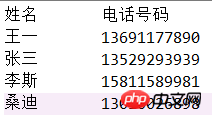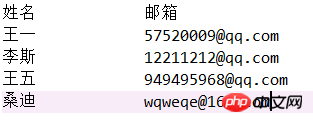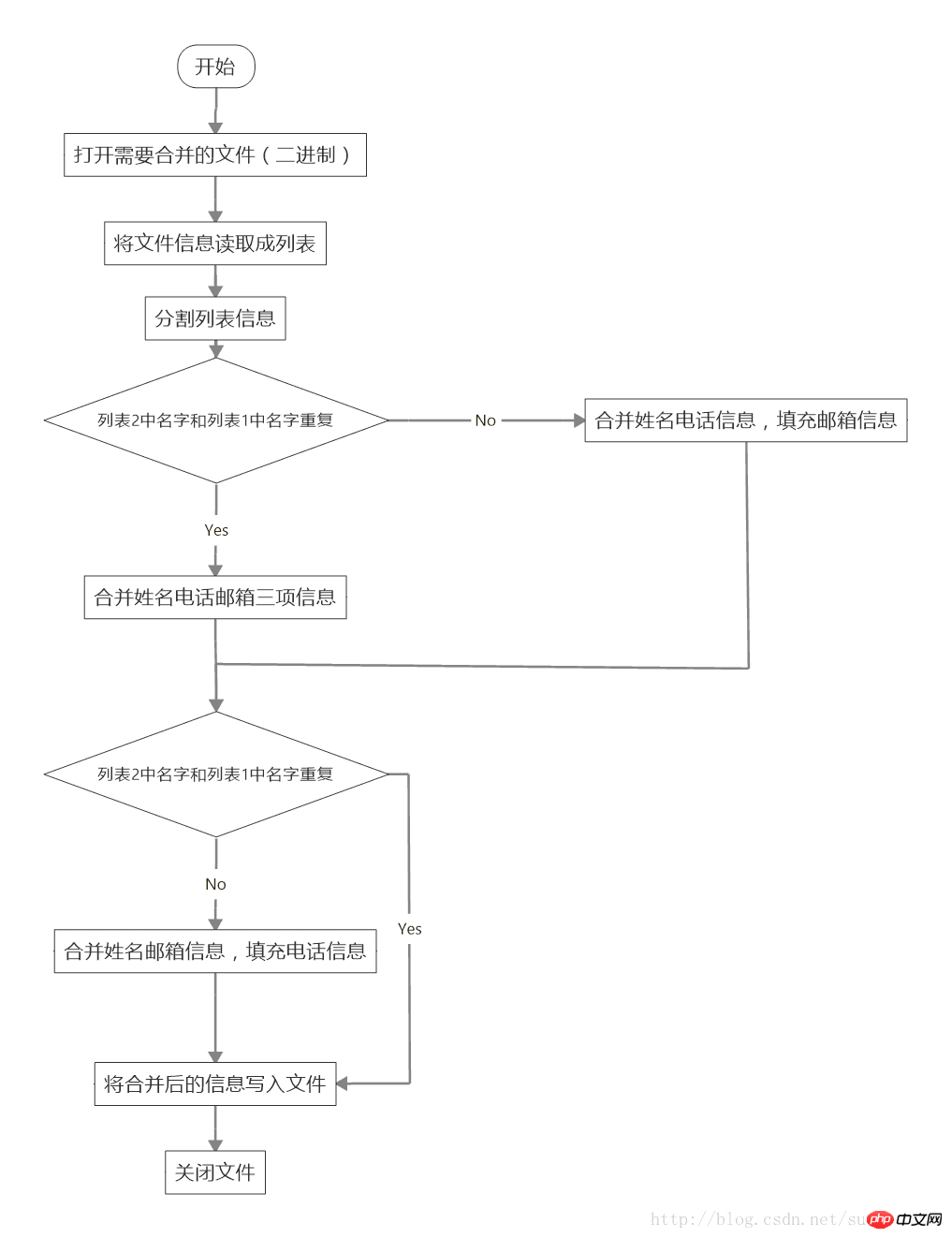Python은 두 파일의 병합 기능을 구현합니다.
이 글에서는 주로 Python에서 두 파일을 병합하는 기능을 자세히 소개합니다. 특정 참조 값을 가진 간단한 파일 병합 프로그램입니다. 관심 있는 친구들이 참고할 수 있습니다.
이 글에서는 파일 병합 방법을 분석하고 지적합니다. 파일 병합 과정에서 주의가 필요한 문제.
다음은 병합해야 하는 파일의 예입니다.


분석 아이디어:
두 파일을 병합하려면 먼저 파일을 메모리로 읽어서 목록으로 만듭니다. 그런 다음 목록을 분할하여 카테고리, 즉 이름, 전화번호, 이메일 주소에 따라 데이터를 별도로 저장합니다. List 1을 순회하여 List 2와 차례로 비교합니다. 둘 중에 겹치는 사람이 있으면 직접 .join([ ])을 사용하여 이름, 전화번호, 이메일을 하나의 행으로 병합하고 다른 목록 변수에 저장합니다. 두 개가 겹치지 않는다면 목록 1에만 있다는 뜻이므로 이 사람의 이메일 정보는 str('—-')로 대체됩니다.
이 순회 후 목록 1의 모든 사람과 목록 2 및 목록 1의 중복 사람이 새 목록 변수에 다시 통합되었습니다. 다음으로 목록 2의 고유한 사람을 새 목록 변수에 추가해야 합니다. 방법은 리스트 2를 순회하면서 리스트 1과 겹치지 않는 사람들을 꺼내서 저장하는 것이다.
마지막으로 새 목록 변수의 데이터를 새 파일에 쓰고 모든 파일을 닫습니다.
흐름도는 다음과 같습니다.

코드는 다음과 같습니다.
"""
Created on Fri Aug 4 12:59:36 2017
@author: 13323
"""
# This program can combine two or more files into one file.
def main():
#firstly open the files
data1 = open("test_3.txt","rb")
data2 = open("test_4.txt","rb")
# read the data in file into list
data1.readline() #only read one line, skip the first line
data2.readline() #only read one line, skip the first line
file1 = data1.readlines() #read all variable into list file1
file2 = data2.readlines() #read all variable into list file2
#print(file1)
#define particular list to store variable
file1_name = []
file1_tel = []
file2_name = []
file2_email = []
#file3 = []
#split file1 into two part
for line in file1:
element = line.split() #line.split(); devide by ' '
file1_name.append(str(element[0].decode('gbk')))
file1_tel.append(str(element[1].decode('gbk')))
#split file2 into two part
for line in file2:
element = line.split()
file2_name.append(str(element[0].decode('gbk')))
file2_email.append(str(element[1].decode('gbk')))
# pick up the name in the file1 same as the name in the file2 and combine
file3 = []
for i in range(len(file1_name)):
s = ''
if file1_name[i] in file2_name:
j = file2_name.index(file1_name[i])
s = '\t'.join([file1_name[i],file1_tel[i],file2_email[j]])
s += '\n'
else:
s = '\t'.join([file1_name[i],file1_tel[i],str("----")])
s += '\n'
file3.append(s)
#pick up the name in the file1 doesn't same as the name in the file2
for i in range(len(file2_name)):
s = ''
if file2_name[i] not in file1_name:
s = '\t'.join([file2_name[i],str('----'),file2_email[i]])
s += '\n'
file3.append(s)
#write the data into file3
data3 = open("test_5.txt","w")
data3.writelines(file3)
#close the file
data1.close()
data2.close()
data3.close()
main()핵심 포인트:
인코딩 및 디코딩
목록 병합 및 해체
관련 추천:
위 내용은 Python은 두 파일의 병합 기능을 구현합니다.의 상세 내용입니다. 자세한 내용은 PHP 중국어 웹사이트의 기타 관련 기사를 참조하세요!

핫 AI 도구

Undresser.AI Undress
사실적인 누드 사진을 만들기 위한 AI 기반 앱

AI Clothes Remover
사진에서 옷을 제거하는 온라인 AI 도구입니다.

Undress AI Tool
무료로 이미지를 벗다

Clothoff.io
AI 옷 제거제

AI Hentai Generator
AI Hentai를 무료로 생성하십시오.

인기 기사

뜨거운 도구

메모장++7.3.1
사용하기 쉬운 무료 코드 편집기

SublimeText3 중국어 버전
중국어 버전, 사용하기 매우 쉽습니다.

스튜디오 13.0.1 보내기
강력한 PHP 통합 개발 환경

드림위버 CS6
시각적 웹 개발 도구

SublimeText3 Mac 버전
신 수준의 코드 편집 소프트웨어(SublimeText3)

뜨거운 주제
 7566
7566
 15
15
 1386
1386
 52
52
 87
87
 11
11
 61
61
 19
19
 28
28
 105
105
 PHP 및 Python : 코드 예제 및 비교
Apr 15, 2025 am 12:07 AM
PHP 및 Python : 코드 예제 및 비교
Apr 15, 2025 am 12:07 AM
PHP와 Python은 고유 한 장점과 단점이 있으며 선택은 프로젝트 요구와 개인 선호도에 달려 있습니다. 1.PHP는 대규모 웹 애플리케이션의 빠른 개발 및 유지 보수에 적합합니다. 2. Python은 데이터 과학 및 기계 학습 분야를 지배합니다.
 Python vs. JavaScript : 커뮤니티, 라이브러리 및 리소스
Apr 15, 2025 am 12:16 AM
Python vs. JavaScript : 커뮤니티, 라이브러리 및 리소스
Apr 15, 2025 am 12:16 AM
Python과 JavaScript는 커뮤니티, 라이브러리 및 리소스 측면에서 고유 한 장점과 단점이 있습니다. 1) Python 커뮤니티는 친절하고 초보자에게 적합하지만 프론트 엔드 개발 리소스는 JavaScript만큼 풍부하지 않습니다. 2) Python은 데이터 과학 및 기계 학습 라이브러리에서 강력하며 JavaScript는 프론트 엔드 개발 라이브러리 및 프레임 워크에서 더 좋습니다. 3) 둘 다 풍부한 학습 리소스를 가지고 있지만 Python은 공식 문서로 시작하는 데 적합하지만 JavaScript는 MDNWebDocs에서 더 좋습니다. 선택은 프로젝트 요구와 개인적인 이익을 기반으로해야합니다.
 Docker 원리에 대한 자세한 설명
Apr 14, 2025 pm 11:57 PM
Docker 원리에 대한 자세한 설명
Apr 14, 2025 pm 11:57 PM
Docker는 Linux 커널 기능을 사용하여 효율적이고 고립 된 응용 프로그램 실행 환경을 제공합니다. 작동 원리는 다음과 같습니다. 1. 거울은 읽기 전용 템플릿으로 사용되며, 여기에는 응용 프로그램을 실행하는 데 필요한 모든 것을 포함합니다. 2. Union 파일 시스템 (Unionfs)은 여러 파일 시스템을 스택하고 차이점 만 저장하고 공간을 절약하고 속도를 높입니다. 3. 데몬은 거울과 컨테이너를 관리하고 클라이언트는 상호 작용을 위해 사용합니다. 4. 네임 스페이스 및 CGroup은 컨테이너 격리 및 자원 제한을 구현합니다. 5. 다중 네트워크 모드는 컨테이너 상호 연결을 지원합니다. 이러한 핵심 개념을 이해 함으로써만 Docker를 더 잘 활용할 수 있습니다.
 터미널 VSCODE에서 프로그램을 실행하는 방법
Apr 15, 2025 pm 06:42 PM
터미널 VSCODE에서 프로그램을 실행하는 방법
Apr 15, 2025 pm 06:42 PM
vs 코드에서는 다음 단계를 통해 터미널에서 프로그램을 실행할 수 있습니다. 코드를 준비하고 통합 터미널을 열어 코드 디렉토리가 터미널 작업 디렉토리와 일치하는지 확인하십시오. 프로그래밍 언어 (예 : Python의 Python Your_file_name.py)에 따라 실행 명령을 선택하여 성공적으로 실행되는지 여부를 확인하고 오류를 해결하십시오. 디버거를 사용하여 디버깅 효율을 향상시킵니다.
 Python에서 비주얼 스튜디오 코드를 사용할 수 있습니다
Apr 15, 2025 pm 08:18 PM
Python에서 비주얼 스튜디오 코드를 사용할 수 있습니다
Apr 15, 2025 pm 08:18 PM
VS 코드는 파이썬을 작성하는 데 사용될 수 있으며 파이썬 애플리케이션을 개발하기에 이상적인 도구가되는 많은 기능을 제공합니다. 사용자는 다음을 수행 할 수 있습니다. Python 확장 기능을 설치하여 코드 완료, 구문 강조 및 디버깅과 같은 기능을 얻습니다. 디버거를 사용하여 코드를 단계별로 추적하고 오류를 찾아 수정하십시오. 버전 제어를 위해 git을 통합합니다. 코드 서식 도구를 사용하여 코드 일관성을 유지하십시오. 라인 도구를 사용하여 잠재적 인 문제를 미리 발견하십시오.
 VScode 확장자가 악의적입니까?
Apr 15, 2025 pm 07:57 PM
VScode 확장자가 악의적입니까?
Apr 15, 2025 pm 07:57 PM
VS 코드 확장은 악의적 인 코드 숨기기, 취약성 악용 및 합법적 인 확장으로 자위하는 등 악성 위험을 초래합니다. 악의적 인 확장을 식별하는 방법에는 게시자 확인, 주석 읽기, 코드 확인 및주의해서 설치가 포함됩니다. 보안 조치에는 보안 인식, 좋은 습관, 정기적 인 업데이트 및 바이러스 백신 소프트웨어도 포함됩니다.
 파이썬 : 자동화, 스크립팅 및 작업 관리
Apr 16, 2025 am 12:14 AM
파이썬 : 자동화, 스크립팅 및 작업 관리
Apr 16, 2025 am 12:14 AM
파이썬은 자동화, 스크립팅 및 작업 관리가 탁월합니다. 1) 자동화 : 파일 백업은 OS 및 Shutil과 같은 표준 라이브러리를 통해 실현됩니다. 2) 스크립트 쓰기 : PSUTIL 라이브러리를 사용하여 시스템 리소스를 모니터링합니다. 3) 작업 관리 : 일정 라이브러리를 사용하여 작업을 예약하십시오. Python의 사용 편의성과 풍부한 라이브러리 지원으로 인해 이러한 영역에서 선호하는 도구가됩니다.
 Windows 8에서 코드를 실행할 수 있습니다
Apr 15, 2025 pm 07:24 PM
Windows 8에서 코드를 실행할 수 있습니다
Apr 15, 2025 pm 07:24 PM
VS 코드는 Windows 8에서 실행될 수 있지만 경험은 크지 않을 수 있습니다. 먼저 시스템이 최신 패치로 업데이트되었는지 확인한 다음 시스템 아키텍처와 일치하는 VS 코드 설치 패키지를 다운로드하여 프롬프트대로 설치하십시오. 설치 후 일부 확장은 Windows 8과 호환되지 않을 수 있으며 대체 확장을 찾거나 가상 시스템에서 새로운 Windows 시스템을 사용해야합니다. 필요한 연장을 설치하여 제대로 작동하는지 확인하십시오. Windows 8에서는 VS 코드가 가능하지만 더 나은 개발 경험과 보안을 위해 새로운 Windows 시스템으로 업그레이드하는 것이 좋습니다.




